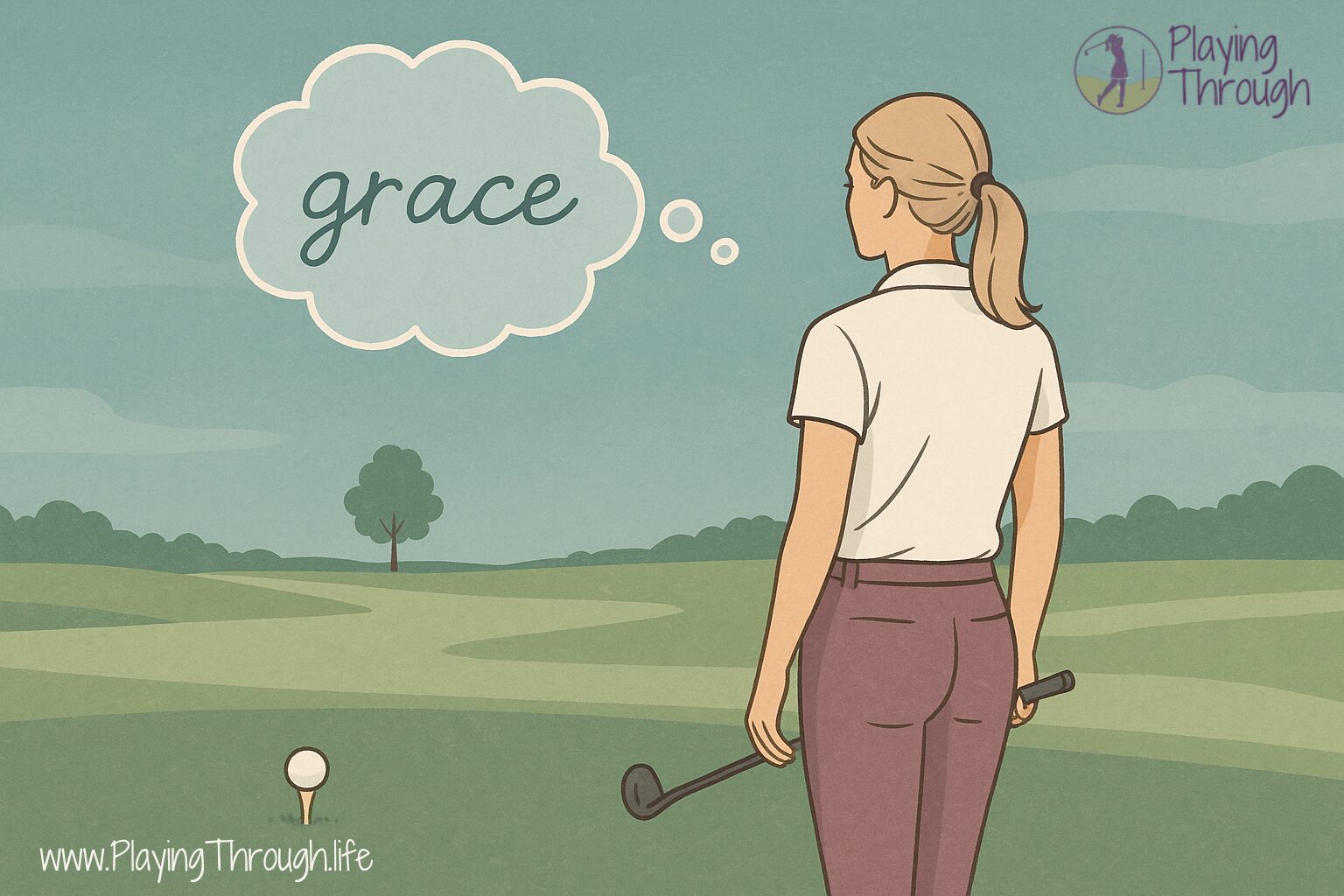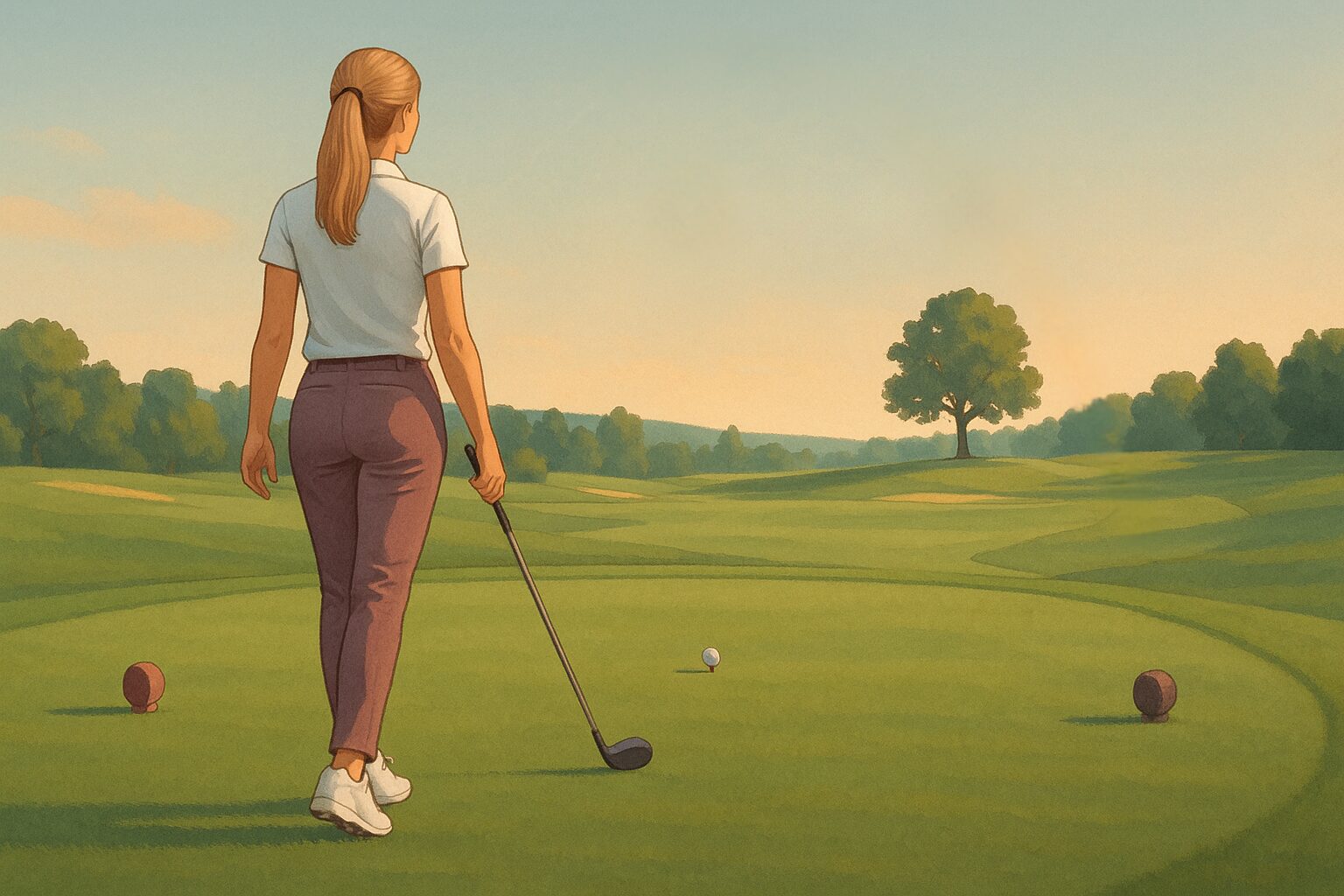Because telling my brain to “just clear your mind” went about as well as you’d expect.
🏌️♀️ Tee Box Confessions
For a long time, my main goal on the tee box was simple:
Don’t embarrass yourself.
I didn’t say it out loud, of course. But that was the quiet mantra humming in the back of my mind as I stood over the ball. Not “hit it straight.” Not “smooth tempo.” Just: please don’t top it in front of these people.
The real problem? I hated approaching golf that way.
But as a returning golfer—someone who hadn’t played much in the last couple of decades—I was rusty, self-conscious, and flooded with way too many swing thoughts. And when you have a neurospicy brain like mine (hello, ADHD), trying to “quiet your mind” is like asking a toddler to chill during a sugar crash.
So instead of trying to silence my thoughts, I gave them a job.
Not a checklist of mechanics. Not a motivational pep talk.
A rhythm. A routine. A path.
And I named it: G.R.A.C.E.
Swing Thought Greatest Mis-Hits
Things I tried before G.R.A.C.E.—and the mental chaos that ensued.
Impossible. My ADHD would like a word.
Fun fact: you can’t pause when your brain is panicking.
Now I’m stuck in a tense crouch over the ball, terrified to move.
Add a single and succinct list item
Cool. Now I’m doing the cha-cha with a driver in my hand.
And suddenly I’m swinging in molasses.
Bold of you to assume my hips and torso are on speaking terms.
I would, but I’ve entered the overthinking vortex.
Why I Needed G.R.A.C.E.
I played a lot of golf as a teenager. Back then, my pre-shot routine was more muscle memory than mindfulness. I didn’t overthink it because I didn’t have to.
Now? Things are different.
- Courses have GPS apps now (shoutout to 18Birdies), and I use them religiously.
- I’ve got 20 more years of muscle and tension memory.
- I know enough about golf to psych myself out in five different directions before I even start my backswing.
I needed something that worked with — not against — how my brain functions. I tend to spiral into overanalysis when I’m under pressure. This routine:
- Builds a mental separation between strategy and execution
- Uses physical anchors (like walking in or breathing)
- Gives me a step-by-step that I can repeat even on a bad hole or with people watching
It’s especially helpful if you’re neurodivergent, high-strung, or just tired of losing shots to indecision. G.R.A.C.E. helps me stay present. It keeps me focused on what I can control—my preparation and mindset—rather than what I can’t.
It’s not a magic bullet. But it’s a lot better than hoping for the best.
What Does G.R.A.C.E. Stand For?
|
Step |
Meaning |
Cue |
|---|---|---|
|
G |
Gather Information & Gameplan |
What’s the situation? |
|
R |
Route Planning |
What’s the shot? |
|
A |
Approach the Ball |
Walk in and get set — G.A.P.S. |
|
C |
Center Yourself |
Exhale. Feel grounded. Trust it. |
|
E |
Execute Gracefully |
Swing free. |
The G.R.A.C.E. Routine – Step by Step
G— Ground Yourself and Set the Gameplan
Because modern golf has Google Maps now.
Before I even step into the tee box, I’m reviewing the hole on 18Birdies. I check:
- Distances to the pin, bunkers, trees, and trouble
- Wind direction and speed
- Lie quality (tight, rough, slope)
- Where my best landing zone would be
- Which club gives me the best chance of ending up in a playable spot
This is the “science” part. No feels, no vibes. Just facts.
If there’s danger right—and my driver’s been pushing that way—I take it into account. I won’t always club down, but I’ll sometimes aim differently. If I’m between clubs, I know my hybrid has a tendency to outperform. If I’m holding a wood, I’m almost always expecting a draw, so I pick a rightish target and visualize the arc.
It’s not about overthinking—it’s about knowing what I want before I swing.
R— Route Planning
Stay behind the ball and picture the full shot shape:
- High or low? Draw or fade?
- Where’s your landing spot?
- Where can you miss safely?
This is where imagination and commitment meet. Pick your shot. Picture it. Let it feel real.
And here’s the secret sauce:
Eyes up. Focus long. Aim small.
Once I’m on the tee box, I pick a very specific, visible target way downrange—a single branch, a roofline edge, a flagpole. Something my brain can actually see and fixate on.
Then I work backward to a clear intermediate target—not a tiny blade of grass that shifts when I move, but something obvious and consistent from behind the ball and beside it.
I actually choose where I tee up based on making that intermediate target easy to align with. That way, my eyes and body are working together—not guessing.
This is the “artist” part. It’s creative, athletic visualization. And yes, sometimes you just picture a safe punch-out. That counts too.
A — Approach the Ball
This is your physical transition into the shot. Step into it with purpose.
This is the body’s cue: “We’re doing the thing now.”
- Run your G.A.P.S. routine: Grip, Alignment, Posture, Stance
- Match your feet and clubface to the intermediate target
- Let your walk-in set your angle — not your shoulders
Why I Stopped Freestyling My Setup
G.A.P.S. turned my guesswork into a routine—and my routine into a reset button.
For the last few weeks, my setup routine has been… let’s say interpretive. I’ve been trying to remember what I used to think about before a shot—back when I was playing regularly twenty years ago—but mostly it felt like guesswork with good intentions. Then Kathy, my instructor at Kowality Golf, introduced me to G.A.P.S., and it instantly gave my swing a home base. Grip. Alignment. Posture. Stance. Four small things that make a big difference—especially when my brain starts freelancing.
Your hands are the only connection to the club—make them count. Aim for a neutral grip with light pressure, like holding a tube of toothpaste you don’t want to squeeze.
Clubface at your target, body square to that line. It sounds simple—but if I’m ever way off, it’s usually because I wasn’t actually aimed where I thought I was.
Tilt from the hips, not the waist. Bow to the ball. Athletic, relaxed, and ready—not hunched or locked up like you’re bracing for a storm.
Feet about shoulder-width apart, weight balanced, ball positioned with purpose. Not just where it feels “right”—where it is right for the club you’re holding.
This is where overthinking stops. Let your body take over. No more changing plans.
Let this feel ritualistic. Like an actor stepping onto stage — confident, grounded, ready.
C— Center Yourself
Before the swing, take one last breath.
- Settle into balance
- Let go of over-control
- Reaffirm your shot and feel ready to go
- Anchor to one swing thought. I often use:
- “Watch it disappear.”
- “Let the club do the work.”
- “Club face square”
- “Slow and smooth.”
This is your moment to be both calm and decisive. Let your setup settle — and mentally commit. Your mind has one job now: stay in rhythm and trust the move.
Your cue: Exhale. Trust it. Commit.
E—EExecute with Grace
Swing. No hesitation. No tinkering. Let it go.
This is your green light. No story, no doubts, no edits. Just movement. This is not the moment to analyze — it’s the moment to trust.
Let the swing happen. Stay connected to your tempo or feel cue. You’ve centered. You’ve committed. Now commit to motion.
If you’ve done the first four steps, this one should feel automatic. It may not be perfect — but it will be honest.
Nothing fancy. You’ve already done the work. Now just swing free.
How It’s Helped Me
- I no longer freeze over the ball
- I can recover from bad shots faster — because I know why it went wrong
- I play faster and with more intention
- I’ve had more solid shots under pressure, especially in league play
It also links directly to my post-shot routine (“See it. Say it. Save it. Shift.”) — so I stay in rhythm.
💬 Final Thoughts
I’m not trying to be perfect. I’m trying to be present.
This routine gives me something solid to stand on—mentally and physically—when my brain wants to spiral and my arms want to swing out of sequence.
Grace isn’t about style.
It’s about presence. Rhythm. Trust.
And a swing that reflects the prep you put in.
Grace Before the Swing
It’s not about thinking less. It’s about thinking on purpose.



Love this Julie! My favorite is execute with trust! (Not force)!
Thanks Lisa! I’m really looking forward to our round tomorrow. I saw you ask about the range being open before our tee time – do you want to hit some balls together beforehand?